|
|
|
|
Contact:
Wax has a great deal of heat potential per ounce but can be difficult to harness enough to make it worthwhile as much of the heat is used to heat up and melt the wax and some of the fuel will go unburnt and blacken your pot. Stoves fueled by paraffin wax (not to be confused with kerosene - often referred to as paraffin) generally incorporate a wick and are basically wide candles with enough wick(s) to cook. These stoves have their own advantages and drawbacks compared to other stove types.
Advantages of Wax Stoves:
ok for melting snow if you're willing to sit and tell stories in your snowcave
used as a light source
used as an emergency heat source in confined areas (snowcave, tent or vehicle)
used as a zipper lubricant
used to waterproof matches
used to make fire starters (melt over dry tinder or kindling)
used to help produce the right atmosphere for telling scary stories
can be taken on an airplane
Drawbacks of Wax Stoves:
produce a lot of soot
generally easy to blow out with minimal wind
many only capable warming food and wont' bring water to a boil
G-Micro PSL Wax Gasifier Stove
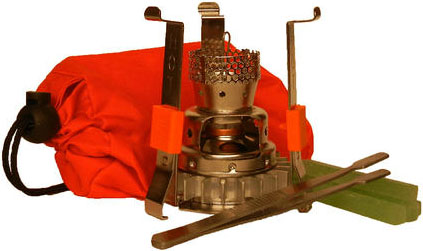
The G-Micro PSL wax gasifying stove will melt, gasify and burn solid wax and is purpose made for solo and duo outdoors use. It will also burn alcohol and a few other liquid fuels which makes it a truly multi-fuel stove. This makes for a very useful travel stove which runs on economical, waterproof fuel (wax) which will never spill in your pack. The G-Micro PSL with wax fuel can even be checked at an international airport which can make adventure traveling that much less complicated since you don't need to spend time looking for fuel at your destination as it's already packed. If you run out of fuel, you can use alcohol or wax from cut up candles, which are generally available world wide. It will also burn kerosene in a pinch, but will leave your pot quite sooty.
There are certainly downsides to using this and other wax powered stoves, but there are certain applications where this one will shine.
Our detailed review of the G-Micro PSL can be found on our G-Micro PSL Review Page.
Related Links:
Gatt-Gen Makers of the G-Micro PSL
Paraffin Candle Stoves
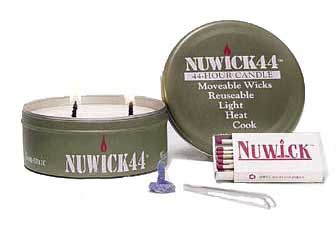
Nuwick paraffin candle stoves strive to be so environmentally friendly that they use soy wax in their stoves. You might be able to bring water to a boil with these and they work best indoors and protected from drafts.
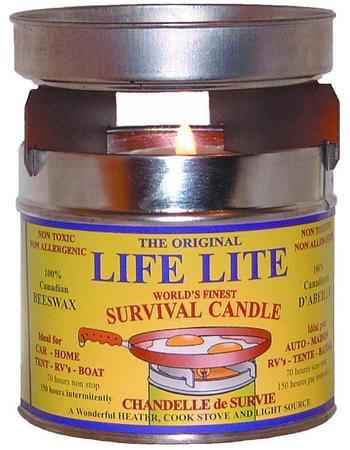
The LIFE LITE line is one of the few commercial beeswax survival candle options on the market. Beeswax is a renewable fuel and is thought to burn cleaner and longer than paraffin.
YuCan Survival Stove

Winter Wise: Travel and Survival in Ice and Snow By Montague Alford
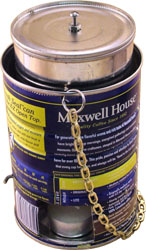
The YuCan Survival Stove and related candle stoves allow you a simple way to heat up food or melt snow for drinking water. Adding a chain allows you to hang this and use it as a lantern. These stoves can be made from recycled so production cost is next to nothing. These can also be safely stored in your car, home or bugout bag indefinitely.
Related Links:
books.google.com Winter Wise: Travel and Survival in Ice and Snow By Montague Alford
Tealight Candles
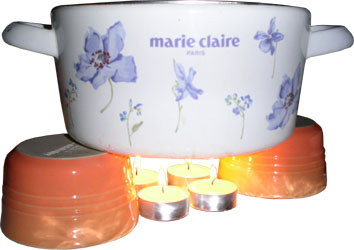
Candle Stove Cooking ローソクコンロでクッキング
Tealights are widely used to cook with and to heat up tea and other items.
Related Links:
Candle Stove Cooking ローソクコンロでクッキング ameblo.jp rarakoko-kotakota
backpackingchef.com Backpacking-stoves
Cooking with Candles on a Tin Can Stove
politics.ie 4381781 4394667 4420122
patverettosfrugalliving.blogspot variation-on-theme-candle-stove
Candle Lanterns
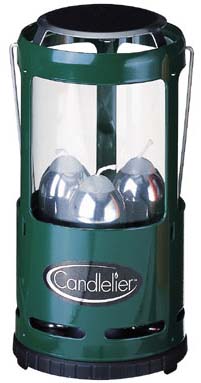
over 20oz Candlelier Candle Lantern
Candle Lanterns are built with a transparent windscreen/chimney so that you can use the candle as a light without it blowing out. Some are even built with a stove top to allow you to melt, warm and/or boil. These tend to be made with glass and are on the heavy side.
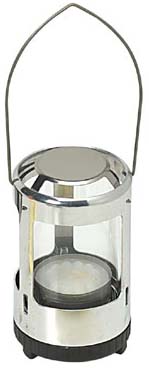
3.2oz Mini Lantern
Smaller commercial tea candle lanterns may be lighter than their pound-plus brothers but are still on the hefty side for an ultralight hiker.
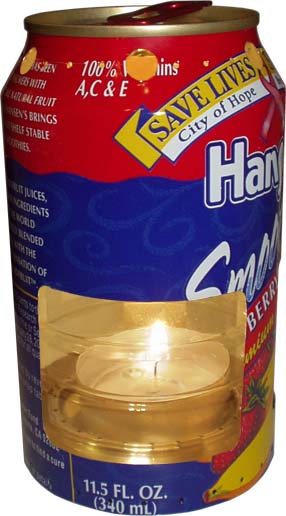
0.5oz (without tealight) Aluminum can lantern/stove
Body - 12oz aluminum can
Floor - pressed in inverted aluminum can bottom
Chimney - plastic water bottle
Ventilation - 6 x 1/4" holes along top shoulder (if used as stove)
To operate - lift chimney and slip in lit candle
A lightweight homemade lantern can be as simple as using a cut down plastic bottle for a wind screen or a bit fancier and constructed to be mobile, hangable and/or useable as a stove. The one above is lightweight and functions as both a candle lantern and as a stove. This sootless system works great for slowly heating up and keeping tea hot or for melting snow while providing a nice night light. If you want to use an aluminum can as a teapot, you might want to make your lantern out of a Guinness beer can which will support just about any size can (including a 24oz Heineken can). See the Templates Page for template and Building Directions for more information.
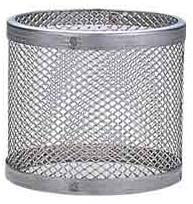
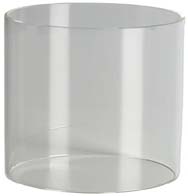
Note - various sized lantern chimney/globes can be purchased or made in stainless mesh or glass for those wanting something more heat resistant than a PET plastic.

Paper Zen Lantern
A plastic chimney will work if you are careful loading lit candles into your lantern and don't build them too narrow or tall for your flame. In fact, if you are skeptical about using non-flameproof materials in a stove or lantern, consider that the Chinese have been making lanterns made from paper and bamboo (Chinese - deng 纸灯; Japanese - chochin 提灯) since 250 BC. Paper lanterns don't seem weather resistant or durable enough for most hikers' use, but hey - depending on materials and design, you may be quite surprised.
Buddy Burners (aka Wax Survival Stove)

3.6oz Wax over corrugated cardboard in candy tin
Note Candle wick in center to allow for lighting
this one was topped off with wax after its last burn
Homemade candle stoves have also been around for centuries. It doesn't take much imagination to envision one of Merlin's alchemists in a darkened room boiling up a small tonic with the heat from a smoky tallow candle. Commonly referred to as Tuna Can Stoves or Buddy Burners, a simple and more modern candle stove can be easily made by pouring melted wax in a metal can (tuna or 7oz cat food is fine) filled with rolled up corrugated cardboard (center wick is optional). If you over fill the wax so that it covers your wick, use a knife to scrape it off before trying to light it.
These candle stoves have several good qualities. They are completely waterproof, don't spill when stored, are easy and economical to make, are not an explosion hazard, don't decompose like other solid fuels, don't require any environmental constraints for storage and are ready to use as is without any special stove or equipment. Their indefinite storage life and easy of construction/use makes them ideal for stockpiling for an emergency. This makes them also popular with survivalists and the Zombie Apocalypse crowd.
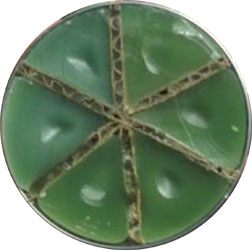
People who actually use this type of stove to cook report that using a cardboard to section off the wax as shown above allows for better air flow to the gasified wax. This allows more efficient burning of wax with less waste.
Related Links:
midwestbushcraft.blogspot. wax-stove
survivalblog.com building_a_dryer_lint_and_wax
YouTube 10lVe_cGn8k Alcohol & vegetable oil stove
zombieapocalypsesurvivalists.com homemade-stove
bryceandkate.blogspot.com how-i-made-my-buddy-burner
randomcreativity.wordpress.com tuna-can-burner
web.archive bushcraftliving.com how-to-make-a-wax-stove - interesting wick pattern
savagesisters.wordpress.com keep-kids-entertained-with-a-hobo-stove Paper/wax stove and Hobo Stove
thesharpenedaxe.blogspot hand-warmerportable-stove-however
Wax Stove Notes
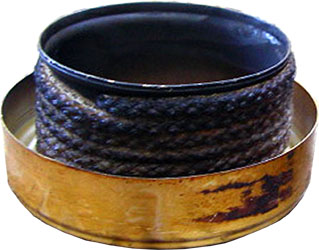
Note: A clean metal can (such as a 12oz drink can or soup can) works fine for melting wax if you don't desire waxing a good pot.
Related Links:
backpackinglight.com Explorations into Candle Stoves
instructables.com Altoids-mess-kit
Fowler, Ryan. The Design of a Wax-burning Stove. University of Johannesburg, 2005
Liquid Wax/Oil Burners
Liquid Candles
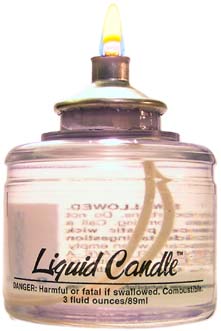
Plastic Liquid Candle
Liquid candles are just like solid candles in that they require a wick to vaporize fuel for burning but also need some sort of holder. Ready made liquid candles can be purchased in either refillable or disposable plastic containers such as the one above (also available in tealight 1oz size), all of which can be refilled (use a needle and syringe for or squeeze fill the non-refillable types) with various flammable fuels and oils.
Vegetable oils, candle fuel, lamp fuel and other liquid oils can be burned with a wick but can be quite sooty, depending on your lamp, wick (type and length) and fuel. Remember that some oils will solidify or gel at low temperatures encountered on winter treks.
Plant/Vegetable Oil Stoves (aka Pflanzenölkocher)
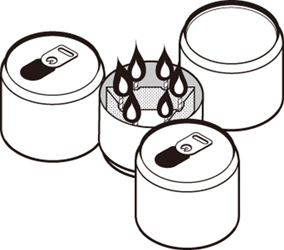
A simple, yet adequate, stove can be made from an aluminum can, aluminum foil and tissue paper. Fuel such as plant or vegetable oil will allow you to cook with this stove system.
Note: According to lodge-tech.net Veg-oil-Stoves:
"Soy bean oil is classed as a drying oil and will leave a residue on metal parts and wick and should not be used, Corn oil leaves a crusty residue on wicks and should not be used. But blends of various oils including these are possible, and can be explored."
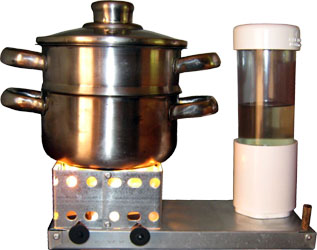
There is a good amount of effort going into creating better vegetable oil burning stoves. Vegetable oil is readily available globally and is very renewable. These stove also offer many in the developing world a cook system with reduced emissions compared to biomass and kerosene fueled stoves.
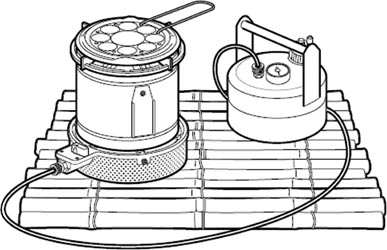
Bosch and Siemens Home Appliances Group (BSH) has released their blueprints for one version of their plant oil cooker for the world to use.
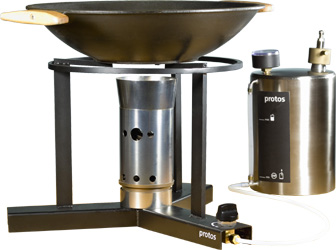
The Plant-Oil Stove Protos is an interesting pressurized stove with stove a double coil burner.
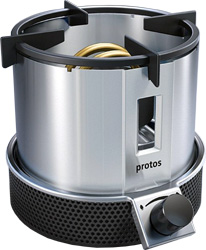
Protos Specifications:
Power Range: 2.2 kW
Efficiency: 55% - 60%
Usage: 1 ltr = 5-7 hrs
Noise Level: 67 - 69 dB
Durability: ~ 10 yrs
Fuel: Various plant oils, plant oil esters and filtered used cooking oil
Emissions: Ten times lower than a high quality kerosene stove
CO2 balance: neutral
Related Links:
sites.google aluminum-can-stove
lodge-tech.net Veg-oil-Stoves Natura Lite Camp stove
tinyhouseblog.com deeks-veggie-oil-heater
tinyhouseblog natura-lite-stove
BSH Plant Oil Cooker Web Archive
bioenergylists.orm 1635 Protos A
dbu.de Pflanzenölkocher 300507110548f386.pdf English
dbu.de Kochen ohne Klimagas, Ruß und Gift
plaza-der-vielfalt.de Protos der Pflanzenölkocher
Oil Lamps
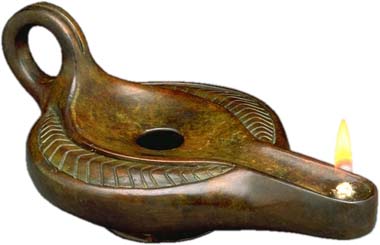
Wood Oil Lantern
These can be a simple a a film canister or aluminum can with a tissue wick or as ornate as the carved wood version shown above. Ideally you will either want a good resealable lamp/stove so that you don't end up with leaks in your pack, or to carefully add just enough fuel (with syringe, straw or very careful pouring) to your lamp/stove as you would with a simple alcohol stove.
|
|
|
|
Extendable glass holder version. |
Recessed base version. |
|
The two versions above are made from film canisters, bottle tops, glass wick holders and fiberglass wicks. To refill, you need to remove the wick holder or bottle top, make a fuel drain hole in the bottle top or use a needle and syringe to inject the wick holder. |
|
If you plan to use plastic containers for lamps, you may need to distance the flame from your plastic parts to prevent melting. You can use a glass tube (wick holder), metal cylinder, or rolled up aluminum to distance the flame.
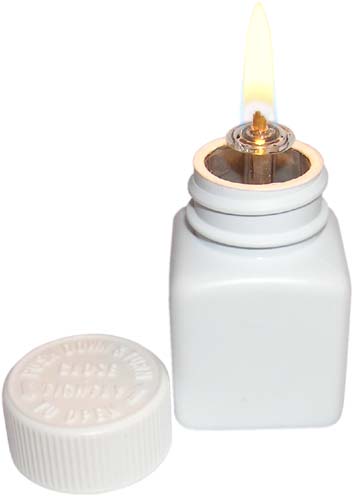
Mini Pill Bottle with extendable/retractable glass wick holder
If you want to use a resalable plastic bottle (e.g. pill bottle) with a narrow opening, you may need to build it so that the wick holder can be pulled up high enough to prevent damage to the container while being able to be pushed back in for storage. Gaskets can be made from bicycle inner tubes or do it yourself gasket sheets found at auto parts stores.
|
|
|
|
This lamp uses a fiberglass wick, a piece of rolled aluminum from a drink can used as a wick holder and has a modified lid to allow for the added height of the wick. An added benefit of drilling and sealing (JB-Weld) the hole n the original lid is that the annoying rotating childproof feature is disabled. |
|
Another option for a narrow topped bottle lamp is modifying the lid so that the wick holder and wick will fit within the top itself. This can be done by drilling a hole in the original lid and epoxying on a second lid (show above).
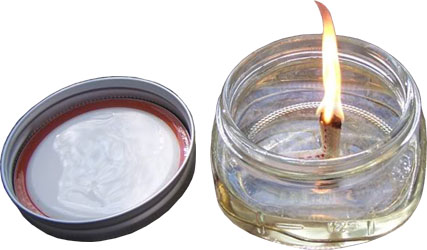
If you would like to get fancy with a beverage can lamp, you can use a Monster Energy Drink can with a resealable lid to make a lamp/stove you can seal when you are done. You can also use a plastic or glass bottle/jar to make a resealable lamp with a built in globe to protect the flame from wind.
Related Links:
The Do It Yourself Vegetable Oil Lamp
stealthsurvival.blogspot diy-survival-gear-making-improvised-oil DIY Survival Gear - Making an Improvised Oil Lamp - Tuna can
tacticalintelligence.net homemade-oil-lamp Tuna Can
funditor.110mb.com FloatingLamp Floating bottle cap wick
electronicsinfoline.com hangable-jam-jar-oil-lamp Floating tealight tin in transparent plastic jam jar
wwwchem.csustan.edu vegoil The Enthalpy of Combustion of Vegetable Oil experiment
davesgarden.com 8078542 8ba733.jpg
zombiehunters.org p862728 Beverage can lamp
zombiehunters.org 43874 Glass Jar Lamp
portugalsmallholding.org make-an-oil-lamp-with-an-orange Orange [fruit] lamp
lehmans.com Olive_Oil_Lamps Glass jar lamps
thesecretyumiverse.wonderhowto.com 4-crafty-ways-diy-emergency-oil-lamp
instructables.com Oil-Pop-Soda-Can-Lantern
Qulliq (aka blubber lamps, Kudlik)

43oz Stone Qulliq
Stone qulliqs (blubber lamps, aka Kudlik) have been used for centuries in Alaska and Siberia. If you are in an area where seal blubber is the only fuel available, a stove can be made from a carved out stone or a an empty tin can. Take a handful of seal fat and mash it down with a kautaq (caribou antler hammer) inside a kaugarvik (stone bowl) and put it in your qulliq. Then set several wicks made with arctic cotton (kanugujak) or moss around one side of the stove and light.
When solid, wax is pretty inert. It doesn't react with water or air, and can even be chewed and swallowed in most cases without much ill consequence, except for the potential of blocking up your intestines. But like with kerosene stoves, there are many who are concerned about exposure to the hydrocarbon byproducts of burning candles.
Many feel that synthetic paraffin creates more soot and cancer causing byproducts when burned compared to beeswax or soy wax. It appears that Philip Fine (1999) found that beeswax does produce a different emissions signature than paraffin wax when burned. Beeswax did produce less sooting but had higher emission rates per mass of wax burned than the paraffin candle due to lower burn rates and longer smoldering times. Emissions from this smoldering would be limited by cutting off the tip of the wick, which avoids the creation of an ember at the end of the wick.
I have been contacted by someone selling paraffin wax products who shared this and this document suggesting that paraffin waxes are as safe as other waxes used to make candles. It is important to note that these studies were funded by several large international paraffin manufacturing associations, so they are likely biased. And even if these reports are "entirely" truthful, these reports lack consideration of key hazards found in burning fumes which may make paraffin as well as other waxes potentially hazardous. It is also equally important to note that a good amount of the claims that beeswax is safer than paraffin waxes likewise comes from those selling beeswax. Soy wax claims are similar.
Soot
The thermal structure of combustion is quire complex for waxes. As it burns, it can produce various flame colors. The blue color is due to chemiluminescence, while the visible yellow color is due to radiative emission from hot soot particles. The soot is formed through a series of complex chemical reactions, leading from the fuel molecule through molecular growth, until multi-carbon ring compounds are formed. The majority of emissions include organic compounds such as alkanes, alkenes, alkanoic acids, wax esters, cyclohexylalkanes, and alkanals.
Soot inhalation has known health hazards. Proper wick trimming and configuration will substantially reduce soot emissions from most candles but will not eliminate them.
The amount of particulate matter found from burning incense and candles is thought to increases your risk of cancer more than burning tobacco.
Chuang HC, Jones T, Bérubé K. Combustion particles emitted during church services: Implications for human respiratory health. Environ Int. 2012 Apr;40:137-42. Epub 2011 Aug 9.
Soto KF, Murr LE, Garza KM. Cytotoxic responses and potential respiratory health effects of carbon and carbonaceous nanoparticulates in the Paso del Norte airshed environment. Int J Environ Res Public Health. 2008 Mar;5(1):12-25.
Fine PM, Cass GR, Simoneit BRT. 1999. Characterization of fine particle emissions from burning church candles. Environmental Science and Technology, 33:2352-2362. Link
Krause D. 1999. Black soot and candles: new research and case studies. Indoor Environment ‘99 Proceedings. pp 157-164. IAQ Publications, Inc., Bethesda, MD.
Lau C, Fiedler H, Hutzinger O, Schwind KH, Hosseinpour J. Levels of selected organic compounds in materials for candle production and human exposure to candle emissions. Chemosphere. 1997 Mar-Apr;34(5-7):1623-30.
Schwind, K.H. and Hosseinpour, J. 1994. Analysis of raw materials and candle combustion products. Oekometric GambH for the Association of German Candle manufacturers, Inc., Baureuth. Germany.
Hot Wax
Wax gets really hot and because of the large size of its molecules, it stores a good deal of energy. So when hot liquid wax hits your skin, it sticks and keeps burning. Once burned, you are more likely to drop or throw your candle and ignite items nearby.
Fires
Fires started by candles are far more common than it should be worldwide. People just don't seem concerned about leaving a burning candle in a room or tent unattended.
Lead
Lead core wicks were common prior to the 1970's where lead
was used to stiffen wicks to hold them erect. The US candle
manufacturing industry voluntarily agreed to cease production of
lead-containing candles in 1974. In the developed world, metals
other than lead are favored in wicks, yet wicks in the developed world
still can contain large amounts of lead in them. In less regulated
parts of the world, you can expect lead to be more common in
candles.
Lead is a known health and developmental hazard and is still the dominating hazard from burning candles. Burning of lead core wick has be shown to produce hazardous levels of lead in the air.
Wasson SJ, Guo Z, McBrian JA, Beach LO. Lead in candle emissions. Sci Total Environ. 2002 Sep 16;296(1-3):159-74.
Sobel HL, Lurie P, Wolfe SM. Lead in candle wicks. JAMA. 2000 Nov 1;284(17):2189-90.
Ungers, L. J., D. R. Kreeger, and R. F. Lands. Determination of Lead Releases from Candles with Zinc-core Wicks. Atkins & Pearce, One Braid Way, Covington, Kentucky (2000)
Ungers, L. J., D. R. Kreeger, and R. F. Lands. Determination of Lead Releases from Candles with Tin-core Wicks. Atkins & Pearce, One Braid Way, Covington, Kentucky (2000)
Nriagu JO, Kim MJ. Emissions of lead and zinc from candles with metal-core wicks. Sci Total Environ. 2000 Apr 24;250(1-3):37-41.
van Alphen M. Emission testing and inhalational exposure-based risk assessment for candles having Pb metal wick cores. Sci Total Environ. 1999 Dec 15;243-244:53-65.
Trace Metals
Metals such including Cd, Cr, Co, Mn, Ni, and Zn are found in addition to lead in candle smoke. These metals cause everything from minor irritation to chronic lung disease to cancer.
Lin TS, Shen FM, Chen JL, Yang MH. Trace metals in candle smoke. Bull Environ Contam Toxicol. 2003 Jan;70(1):182-7.
Carbon Monoxide
This is the odorless part of the smoke and fumes emitted by any wax powered stove or lantern. If you see a yellow flame, you can expect a fair amount of carbon monoxide. If you see a flame, you can expect some amount of carbon monoxide. See our Carbon Monoxide page for more information and this deadly hazard.
Weber LP, Al-Dissi A, Marit JS, German TN, Terletski SD. Role of carbon monoxide in impaired endothelial function mediated by acute second-hand tobacco, incense, and candle smoke exposures. Environ Toxicol Pharmacol. 2011 May;31(3):453-9. Epub 2011 Feb 26.
Aroma Additives
These are all really bad for you. Avoid any waxes with scent additives - even if they claim to ward of mosquitoes or wolves.
Incense
This is only remotely related to stoves, but is worth mentioning. This is really hazardous to one's health. There area several studies that show exposure to incense smoke is related to many illnesses, including cancer, leukemia in children, childhood brain tumors, asthma, and contact dermatitis. A quick search on Pub Med should give you plenty of resources.
Mystical Beeswax
There are many people in this world who believe beeswax candles have some sort of spiritual, mystical and health attributes when burned. Why is this?
Beeswax Candles and the Church
In the days when tallow candles were used, large amounts of soot would cover the precious walls and windows of churches and cathedrals. The use of beeswax candles proved necessary to avoid destruction of these sacred places of God. Since then, use of beeswax candles in churches has been a holy tradition.
Some feel that the pure wax extracted by virgin bees from flowers symbolizes the pure flesh of Christ received from His Virgin Mother, the wick signifies the soul of Christ, and the flame represents His divinity which absorbs and dominates both. And although the two latter properties are found in all kinds of candles, the first is proper of beeswax candles only. This makes beeswax candles irreplaceable for many Christian ceremonies and services.
Negative Ion Emitter
The claim here is that beeswax is the only fuel which emits negative ions when burned. These negative ions are said to purify the air by binding to harmful positive ions, causing them to fall to the ground. The flame is also said to burn away many of these toxins as they are drawn in to the burning candle. And if you are wondering, these said positive ions include dust, odors, toxins, pollen, mold, dust mites feces, and viruses.
Some claims go as far as to say that negative ions are found in high concentrations on seashores, mountain regions, waterfalls and during storms. They combat positive ions (commonly known as free radicals) and are beneficial to the body in four major ways:
They strengthen the functions of autonomic nerves
Reinforce collagen
Improve metabolism
Strengthen the body's immune system
These benefits in turn help people with:
Feelings of wellbeing and happiness
Improved sleep
Increased blood flow
Resistance to disease
Relief from asthma, hay fever and allergies
Improved concentration
Balanced hormone production
Reduced headaches
Are a natural anti-depressant
Counteract the effects of smoking
Although there doesn't seem to be any scientific research backing much of this, it is possible that waterfalls, seashores and other places do have some sort of mystical powers that cleanses or heals the human body or spirit. These are commonly accepted areas for spiritual healing by many, but why would beeswax have a similar effect? I'll leave that up to a different web site to explain.
I have only been able to find the following "information" suggesting some type of possible scientific evidence of negative ions being produced by beeswax candles:
"The Japanese study was performed using a KST-900 made by the Kobe Electric Wave Company in a room with room air temperature of 24.3 degrees Celsius , room air humidity was 41% and the background negative ion count was 89 per cc. During the study , paraffin candles produced an average of 72,972 negative ion particles per cc. of air while beeswax candles produced 101,276 negative ion particles per cc. of air." Canadian Beeswax Chandlers Guild facebook 91215420641
"Burning beeswax produces negative ions that circulate in the room and attract pollutants, in much the same way that a magnet attracts iron filings. Dust, odours, moulds, bacteria, viruses and other toxins are captured and neutralized. Beeswax actually cleans your air!" Entomologist/writer Bill Reno. Bountiful Beeswax. Alive, Canadian Journal of Health and Nutrition #218, December 2000 Alt Link
If anyone has any evidence or literature supporting these claims, please contact me.
Grinshpun SA, Mainelis G, Trunov M, Adhikari A, Reponen T, Willeke K. Evaluation of ionic air purifiers for reducing aerosol exposure in confined indoor spaces. Indoor Air. 2005 Aug;15(4):235-45.
Wu CF, Lai CH, Chu HJ, Lin WH. Evaluating and mapping of spatial air ion quality patterns in a residential garden using a geostatistic method. Int J Environ Res Public Health. 2011 Jun;8(6):2304-19. Epub 2011 Jun 20.
Cai K, Liu X, Xu Y, Ren C, Chen H, Xu J, Yu Z. Damage effects induced by electrically generated negative air ions in Caenorhabditis elegans. Sci Total Environ. 2008 Aug 15;401(1-3):176-83. Epub 2008 May 27.
Harmer CJ, Charles M, McTavish S, Favaron E, Cowen PJ. Negative ion treatment increases positive emotional processing in seasonal affective disorder. Psychol Med. 2011 Dec 13:1-8.
Malcolm CP, Cowen PJ, Harmer CJ. High-density negative ion treatment increases positive affective memory. Psychol Med. 2009 Nov;39(11):1930-2. Epub 2009 Jul 21.
Voeikov VL. Ultra-low luminescence of humid air and its possible role in negative air ion therapy. Indian J Exp Biol. 2008 May;46(5):322-9.
Tyagi AK, Nirala BK, Malik A, Singh K. The effect of negative air ion exposure on Escherichia coli and Pseudomonas fluorescens. J Environ Sci Health A Tox Hazard Subst Environ Eng. 2008 Jun;43(7):694-9.
Wu CC, Lee GW, Yang S, Yu KP, Lou CL. Influence of air humidity and the distance from the source on negative air ion concentration in indoor air. Sci Total Environ. 2006 Oct 15;370(1):245-53. Epub 2006 Aug 17.
Nakane H, Asami O, Yamada Y, Ohira H. Effect of negative air ions on computer operation, anxiety and salivary chromogranin A-like immunoreactivity. Int. J. Psychophysiol. 2002;46:85–89.
Kondrashova MN, Grigorenko EV, Tikhonov AN, Sirota TV, Temnov AV, Stavrovskaja IG, Kosyakova NI, Lange NV, Tikhonov VP. The primary physico-chemical mechanism for the beneficial biological/medical effects of negative air ions. Trans. Plasma Sci. 2000;28:230–237.
Daniell W, Camp J, Horstman S. Trial of a negative ion generator device in remediating problems related to indoor air quality. J Occup Med. 1991 Jun;33(6):681-7.
Buckalew LW, Rizzuto AP. Negative air ion effects on human performance and physiological condition. Aviat Space Environ Med. 1984 Aug;55(8):731-4.
Rosenthal I. A working hypothesis for negative ion generators. Experientia. 1983 Jul 15;39(7):718-9.
Buckalew LW, Rizzuto A. Subjective response to negative air ion exposure.Aviat Space Environ Med. 1982 Aug;53(8):822-3.
Krueger AP, Reed EJ. Biological impact of small air ions. Science. 1976;193:1209–1213.
Wiki Negative air ionization therapy
Beeswax Burns Longer
The claim here is that beeswax burns longer and this negates the extra cost of beeswax over paraffin. In truth, beeswax does burn cooler and longer gram for gram than paraffin. But when you look at the cost of beeswax when compared to paraffin, you will pay more for beeswax for each hour of light you get from your candle.
Beeswax are Natural and Natural is Better
Natural isn't always better, but it does sound good. And when you look at the process for making paraffin, you'll see why so many are willing to pay top dollar for beeswax.
Modern Naturopathic Mysticism
I am in no way suggesting that naturopathic sciences are fraudulent. But in an age where widespread commercialism has influenced all parts of medicine, naturopathic medicine may have have been hit with an unfair blow. And unlike traditional medicine, which is regulated by many governing and regulator bodies, little prevents anyone from saying whatever they like about a naturopathic remedy for the sake of marketing. And much of the information found on web sites selling beeswax products seem copy information off of competitor sites and propagate or even enhance what may very well be myth.
Honey and beeswax have long been part of traditional medicine in many parts of the world. These produces have been used to treat everything from colds, hay fever, asthma, burns and rheumatism. The wax has and still is used in various ointments over the counter as well as in prescription medications. The wax has been used in many magical practices (voodoo and witchcraft - not cards and rabbits) by various groups practicing their own brand of magic.
Bears!
One common way hunters attract bears is by heating up honey or burning beeswax candles. Bears just LOVE honey! Just ask Whiny the Pooh. And if you are in bear country, bears will take notice when you fire up a beeswax candle or stove. They may even be interested in your solid beeswax candle you have packed away in your pack.
Not all waxes are created equal. And when it comes to a mini wax burner, the type of wax you choose to use will have some impact on stove performance.
Gatt-Gen uses 145F Wax which may have a melt point of around 60-62º C, depending on their wax supplier.
| C10-13 | C11-12 | C11-14 | C12-14 | C14-17 | C17-20 | |
| Flash Point | 73 | 76 | 84 | 92 | 120 | 160 |
N-ALKANES (Straight-Chain)
| Carbon Number | Name | Formula | Melting Point
ºC |
Boiling Point
ºC |
Flash Point
ºC |
CAS RN |
| C(5) | n-Pentane | C5H12 (72.15) | -130 | 35.2 | -57 | 109-66-0 |
| C(6) | n-Hexane | C6H14 (86.18) | -95 | 69 | -22 | 110-54-3 |
| C(7) | n-Heptane | C7H16 (100.20) | -90.5 | 98.5 | −4.0 | 142-82-5 |
| C(8) | n-Octane | C8H18 (114.23) | -57 | 126 | 15.6 | 111-65-9 |
| C(9) | n-Nonane | C9H20 (128.26) | -53 | 158 | 31 | 111-84-2 |
| C(10) | n-Decane | C10H22 (142.28) | -30 | 174 | 46 | 124-18-5 |
| C(11) | n-Undecane | C11H24 (156.31) | -25.5 | 196 | 60 | 1120-21-4 |
| C(12) | n-Dodecane | C12H26 (170.34) | -9.5 | 216 | 71 | 112-40-3 |
| C(13) | n-Tridecane | C13H28 (184.36) | 5.5 | 235 | 102 | 629-50-5 |
| C(14) | n-Tetradecane | C14H30 (198.39) | 6 | 254 | 99 | 629-59-4 |
| C(15) | n-Pentadecane | C15H32 (212.42) | 10 | 271 | 132 | 629-62-9 |
| C(16) | n-Hexadecane | C16H34 (226.44) | 18 | 287 | 135 | 544-76-3 |
| C(17) | n-Heptadecane | C17H36 (240.47) | 22 | 302 | 148 | 629-78-7 |
| C(18) | n-Octadecane | C18H38 (254.50) | 28 | 316 | 165 | 593-45-3 |
| C(19) | n-Nonadecane | C19H40 (268.53) | 32 | 329 | 168.3 | 629-92-5 |
| C(20) | n-Eicosane | C20H42 (282.55) | 37 | 343 | 186.5 | 112-95-8 |
| C(21) | n-Henicosane | C21H44 (296.58) | 40.5 | 356.5 | 198.8 | 629-94-7 |
| C(22) | n-Docosane | C22H46 (310.61) | 44.5 | 368.5 | 210.9 | 629-97-0 |
| C(23) | n-Tricosane | C23H48 (324.63) | 47.5 | 380 | 222.8 | 638-67-5 |
| C(24) | n-Tetracosane | C24H50 (338.66) | 52 | 391 | 234.5 | 646-31-1 |
| C(25) | n-Pentacosane | C25H52 (352.69) | 54 | 402 | 246.1 | 629-99-2 |
| C(26) | n-Hexacosane | C26H54 (366.71) | 56.5 | 412 | 257.6 | 630-01-3 |
| C(27) | n-Heptacosane | C27H56 (380.74) | 59 | 422.1 | 268.9 | 593-49-7 |
| C(28) | n-Octacosane | C28H58 (394.77) | 64.5 | 431.5 | 280.1 | 630-02-4 |
| C(29) | n-Nonacosane | C29H60 (408.79) | 65 | 440.9 | 291.2 | 630-03-5 |
| C(30) | n-Triacontane | C30H62 (422.82) | 66 | 450 | 302.2 | 638-68-6 |
| C(31) | n-Hentriacontane | C31H64 (436.85) | 67 | 458.4 | 313.1 | 630-04-6 |
| C(32) | n-Dotriacontane | C32H66 (450.87) | 69 | 467 | 323.9 | 544-85-4 |
| C(33) | n-Triatriacontane | C33H68 (464.90) | 71 | 474.7 | 334.7 | 630-05-7 |
| C(34) | n-Tetratriacontane | C34H70 (478.93) | 72 | 482.4 | 345.3 | 14167-59-0 |
| C(35) | n-Pentatriacontane | C35H72 (492.95) | 73 | 489.9 | 355.9 | 630-07-9 |
| C(36) | n-Hexatriacontane | C36H74 (506.98) | 74 | 497.1 | 366.4 | 630-06-8 |
| C(37) | n-Heptatriacontane | C37H76 (521.01) | 76 | 504.1 | 376.8 | 7194-84-5 |
| C(38) | n-Octatriacontane | C38H78 (535.03) | 78 | 510.9 | 387.2 | 7194-85-6 |
| C(39) | n-Nonatriacontane | C39H80 (549.05) | 80 | 517.5 | 397.5 | 7194-86-7 |
| C(40) | n-Tetracontane | C40H82 (563.09) | 82 | 523.9 | 407.7 | 4181-95-7 |
| C(42) | n-Dotetracontane | C42H86 (591.13) | 84 | 536.1 | 428.1 | 7098-20-6 |
| C(44) | n-Tetratetracontane | C44H90 (619.20) | 85 | 547.6 | 448.2 | 7098-22-8 |
| C(46) | n-Hexatetracontane | C46H94 (647.24) | 86 | 558.4 | 468.1 | 7098-24-0 |
| C(48) | n-Octatetracontane | C48H98 (675.30) | 90 | 568.7 | 488 | 7098-26-2 |
| C(50) | n-Pentacontane | C50H102 (703.36) | 91 | 578.4 | 507.6 | 6596-40-3 |
| C(52) | n-Dopentacontane | C52H106 (731.40) | 92 | 587.6 | 527 | 7719-79-1 |
| C(54) | n-Tetrapentacontane | C54H110 (759.45) | 93 | 596.4 | 546.4 | 5856-66-6 |
| C(56) | n-Hexapentacontane | C56H114 (787.50) | 94 | 604.7 | 565.7 | 7719-82-6 |
| C(58) | n-Octapentacontane | C58H118 (815.56) | 95 | 612.6 | 584.8 | 7667-78-9 |
| C(60) | n-Hexacontane | C60H122 (843.62) | 96 | 620.2 | 604 | 7667-80-3 |
Beeswax is a tough wax formed from a mixture of several compounds.
| Melting Point | 62 to 64° C (144 to 147° F) |
| Flash Point | 204.4° C (399.9° F) |
| CAS Registry Number | 8012-89-3 |
The most common and cheapest wax used in candles today. It is made from petroleum waste and produces smoke and soot. There is big talk these days about cancer caused by inhalation of paraffin candle smoke. Candles made form this wax are ideal for those who shop at the dollar store (or pound store) and don't worry themselves about cancer reports.
Made by bees, this is considered by many to be the cleanest burning wax around. This may stem from times of old when beeswax was reserved for the church as it is long burning, clean, flagrantly and didn't not stain the precious walls and windows of the church like tallow candles. It also burns much longer and produces more heat per gram than paraffin wax. And because of the lack of smoke and soot, these waxes are considered safe by many.
This fuel is also more expensive than paraffin per gram but their longer burn times may offset the price difference. Some hunters use honey burners or beeswax candles to attract hungry bears, which could be a plus if you are hunting but not such a desirable feature after a long day of hiking. This is probably the best choice of wax for hikers unless the chance of attracting bears and other critters is undesirable.
Beeswax composition:
70 % esters of long chain wax alcohols (C24-C44) with carbon acids (C16/C18)
13-18 % hydrocarbons (C25-C35)
10-15 % free wax acids (C24-C32)
1 % free wax alcohols (C34-C36)
Stearin candles are made up of stearic acid that is often mixed with palmaitic acid. This wax is produced by the saponification (mixing with a strong alkali) of vegetable and/or animal fats. Stearic acid is also used to add firmness to paraffin wax and increases candle burn time.
This wax is made of white mineral oil, gelliants, and butylated hydroxy toluene. Because of their softness, these waxes must be used in containers with ridged wicks. Ideal for those who like colors, smells and don't have allergies.
Ideal for vegan extremists.
Soywax
Soywax is made from hydrogenated soybean oil. Not the best candle material around as it may only melt the core of the candle and can be brittle. It does burn cleaner than paraffin (but produces more soot than beeswax), is considered safe to use and doesn't shrink when it cools.
Carnuba wax
A wax exuded by the leaves of the Brazilian Carnauba Palm nuts.
Ceresine
This is made from palm oil and coconut wastes modified with other vegetable waxes. It is a higher quality wax than paraffin.
BayberryMade from bayberries. A sweet-smelling wax that burns clean.
Tallow and other Animal Fat Waxes
Tallow is made from suet. Very smoky, sooty and produces an acrid odor when burned. Some of these candles were and can be made to be edible and were used on Captain Scott's final expedition to the South Pole in 1910-11. Ideal for those wanting to go medieval.
Stearic acid
This is produced by the saponification (mixing with a strong alkali) of vegetable or animal fats (also found in chocolate) and is used to add firmness to paraffin wax and increases their burn time.
Spermacetiti
Made form the crystallizing oil found in the heads of sperm whales. A one pound candle made form this wax is the standard source of light for one "candle power." Spermaceti wax doesn't produce an acrid odor when burned, is harder than tallow or beeswax, doesn't soften or bend in the summer heat, and produces a pure bright light.
Seal Oil and other animal oils
Oil from blubber can be used with a wick and has been used for centuries in Alaska and Siberia.
Liquid Candle Fuelsls
Many brands are straight kerosene, while others are refined into heavier and cleaner hydrocarbons in liquid form (at room temperature).
Oils such as olive oil can be used for lamps, but tend to burn very sooty.
Wick Types
Non-Cored Wicks
There are commonly made of twisted or woven plant fibers such as cotton. Non-cored wicks are generally considered safe and can be made from cardboard, toilet paper, cigarette paper, bark and even fiberglass insulation to some degree. You can find ready made wick at craft shops in different configurations and even in large spools.
Cored Wicks
Usually cotton braided around a zinc, tin, lead, cotton or paper core. The core adds rigidity to the wick which is needed for candles that easily melt. In 1974 the US National Candle Association agreed to discontinue using lead-cored wicks and in 2003, the US Consumer Product Safety Commission banned lead-cored wicks because of health concern. But even with these bans in place, you can still find lead in candle wicks in the US and in other countries. There are also new concerns about the burning of zinc.
If you are concerned about lead in your wick, you can rub a white piece of paper over an un-burnt wick and look for a lead streak. If it has a lead streak, look for a different candle or wick.
Wick Material
Wicks can be made from a number of materials, both heat/flame resistant and sacrificial. See our Wick Stoves Page for more information.